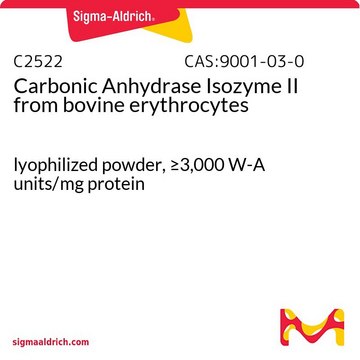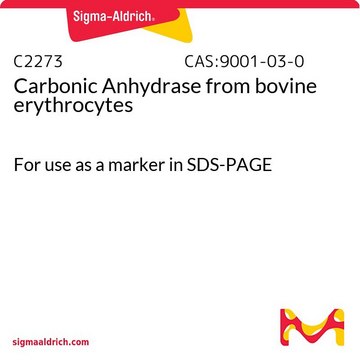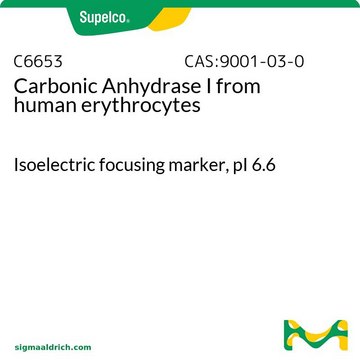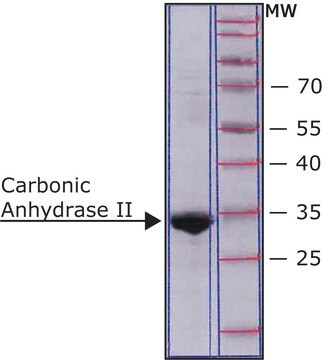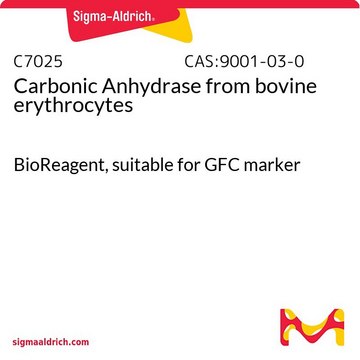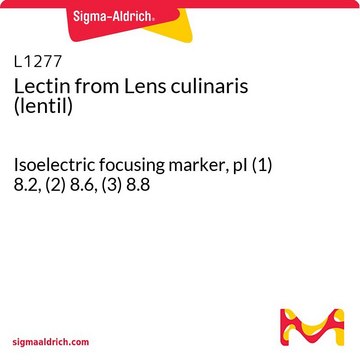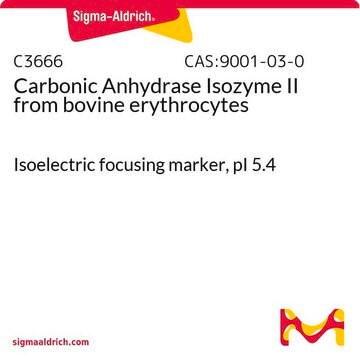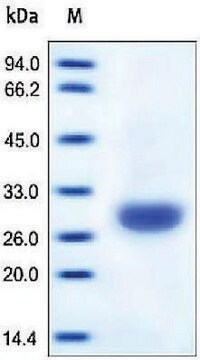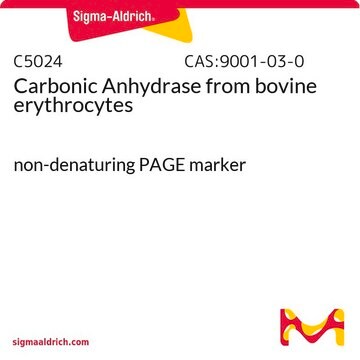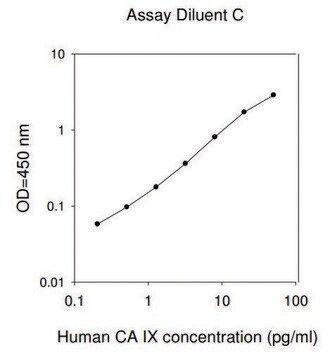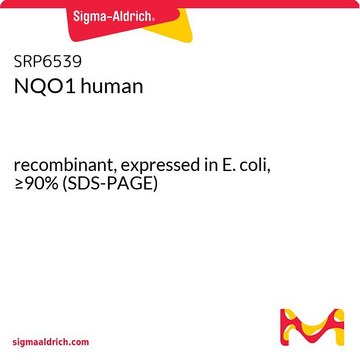C4396
Carbonic Anhydrase I from human erythrocytes
Sinonimo/i:
Carbonate Dehydratase, Carbonate Hydrolyase, Carbonic Anhydrase Isozyme I
Autenticatiper visualizzare i prezzi riservati alla tua organizzazione & contrattuali
About This Item
Prodotti consigliati
Stato
powder
Livello qualitativo
Attività specifica
100-500 W-A units/mg protein
PM
30 kDa
Colore
white
pI
~6.6
N° accesso UniProt
Temperatura di conservazione
−20°C
Informazioni sul gene
human ... CA1(759)
Cerchi prodotti simili? Visita Guida al confronto tra prodotti
Applicazioni
Carbonic anhydrase from human erythrocytes (HCA) has been used to study the molten-globule state of carbonic anhydrase (CA). Chaperone-like α-crystallin binds to this state of the enzyme and prevents its aggregation. The enzyme from sigma has been used for the analysis of thermodynamic stability of the enzyme. Furthermore, its clinical significance has been evaluated in human non-small cell lung cancer.
Azioni biochim/fisiol
Carbonic anhydrase is a zinc metalloenzyme that has a molecular weight of approximately 30,000 Da. The enzyme catalyzes the hydration of carbon dioxide to carbonic acid. It is involved in vital processes such as pH and CO2 homeostasis, transport of bicarbonate and CO2, biosynthetic reactions, bone resorption, calcification, and tumorigenicity. Therefore, this enzyme is an important target for inhibitors with clinical applications in various pathologies such as glaucoma, epilepsy and Parkinson′s disease.
Definizione di unità
One Wilbur-Anderson (W-A) unit will cause the pH of a 0.02 M Trizma buffer to drop from 8.3 to 6.3 per min at 0 °C. (One W-A unit is essentially equivalent to one Roughton-Booth unit.)
Nota sulla preparazione
chromatographically
purified.
purified.
Inibitore
N° Catalogo
Descrizione
Determinazione del prezzo
Avvertenze
Danger
Indicazioni di pericolo
Consigli di prudenza
Classi di pericolo
Resp. Sens. 1
Codice della classe di stoccaggio
11 - Combustible Solids
Classe di pericolosità dell'acqua (WGK)
WGK 3
Punto d’infiammabilità (°F)
Not applicable
Punto d’infiammabilità (°C)
Not applicable
Scegli una delle versioni più recenti:
Possiedi già questo prodotto?
I documenti relativi ai prodotti acquistati recentemente sono disponibili nell’Archivio dei documenti.
I clienti hanno visto anche
K Rajaraman et al.
The Journal of biological chemistry, 271(44), 27595-27600 (1996-11-01)
alpha-Crystallin, a multimeric protein, exhibits chaperone-like activity in preventing aggregation of several proteins. We have studied the chaperone-like activity of alpha-crystallin toward heat-induced aggregation of bovine and human carbonic anhydrase. Human carbonic anhydrase aggregates at 60 degrees C, while bovine
Whei Ling Chiang et al.
Cancer letters, 188(1-2), 199-205 (2002-10-31)
This study was designed to elucidate the possible relationship between the expression of cytosolic carbonic anhydrase (CA) and non-small cell lung cancer (NSCLC). The activity and protein expression patterns of carbonic anhydrase I (CAI) and II (CAII) of 70 NSCLC
Daumantas Matulis et al.
Biochemistry, 44(13), 5258-5266 (2005-03-30)
ThermoFluor (a miniaturized high-throughput protein stability assay) was used to analyze the linkage between protein thermal stability and ligand binding. Equilibrium binding ligands increase protein thermal stability by an amount proportional to the concentration and affinity of the ligand. Binding
Pavel V Shliaha et al.
Journal of proteome research, 12(6), 2323-2339 (2013-03-22)
qTOF mass spectrometry and traveling wave ion mobility separation (TWIMS) hybrid instruments (q-TWIMS-TOF) have recently become commercially available. Ion mobility separation allows an additional dimension of precursor separation inside the instrument, without incurring an increase in instrument time. We comprehensively
Qiang Jin et al.
Biosensors & bioelectronics, 83, 193-199 (2016-04-30)
A near-infrared fluorescent probe (DDAB) for highly selective and sensitive detection of carboxylesterase 2 (CE2) has been designed, synthesized, and systematically studied both in vitro and in vivo. Upon addition of CE2, the ester bond of DDAB could be rapidly
Protocolli
Enzymatic Assay of Carbonic Anhydrase for Wilbur-Anderson Units (EC 4.2.1.1)
Il team dei nostri ricercatori vanta grande esperienza in tutte le aree della ricerca quali Life Science, scienza dei materiali, sintesi chimica, cromatografia, discipline analitiche, ecc..
Contatta l'Assistenza Tecnica.


